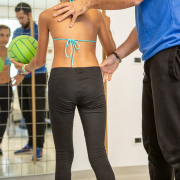Correlation of Paraspinal Muscle Mass With Decompensation of Sagittal Adult Spinal Deformity After Setting of Fatigue Post 10-Minute Walk
Every year, the Italian Scoliosis Study Group selects the best published papers on conservative spine treatment from the global scientific literature.
Here is the abstract from one of these papers.
Correlation of Paraspinal Muscle Mass With Decompensation of Sagittal Adult Spinal Deformity After Setting of Fatigue Post 10-Minute Walk
Junseok Bae, Ashwin Sathe, Shih-Min Lee, Alexander A Theologis, Vedat Deviren, Sang-Ho Lee
Neurospine, PMID: 3461068 PMCID: PMC8497245, DOI: 10.14245/ns.2142510.255
Abstract
Objective: The purpose of this study was to investigate the changes in spinopelvic parameters before and after the setting of muscle fatigue along with its correlation with pre-existing paraspinal and psoas muscle mass.
Methods: Single-center retrospective review of prospectively collected data was conducted on 145-adults with symptomatic loss of lumbar lordosis (LL). Radiographs were taken before and after walking for 10 minutes. Magnetic resonance imaging was used to calculate paraspinal muscle (PSM) cross-sectional area (CSA), mean signal intensity, fatty infiltration (FI), and lean muscle mass at thoracolumbar junction (T12) and lower lumbar level (L4). Psoas CSA was calculated at L3. Patients were divided into 2 groups namely compensated sagittal deformity (CSD) (SVA ≤ 4 cm, PT > 20°) and decompensated sagittal deformity (DSD) (SVA > 4 cm, PT > 20°) based on prewalk measurements.
Results: Initial mean SVA was 1.8 cm and 11 cm for CSD and DSD respectively (p < 0.01). After walking, significant deteriorations in SVA, PT-LL (p < 0.01) were observed in CSD without significant change in thoracic kyphosis (TK). All sagittal parameters in DSD deteriorated significantly. DSD group had significantly poorer PSM quality at T12 and L4 compared to CSD group. In CSD group, sagittal decompensation correlated with muscle quality, i.e. , decreases in LL (ΔLL) correlated with CSA of PSM/vertebral body (VB) at L4 (r = -0.412, p = 0.046) while increases in TK (ΔTK) correlated with CSA of PSM/VB at T12 (r = 0.477, p = 0.018). ΔSVA and ΔPT correlated with FI at L4 (r = 0.577, p = 0.003 and r = -0.407, p = 0.048, respectively). DSD group, had weak correlations (-0.3 < r < -0.1) between changes in sagittal and PSM parameters.
Conclusion: PSM quality in adults with spinal deformity correlates with patients’ ability to maintain an upright posture and sagittal decompensation after walking for 10 minutes.
Keywords: Deformity; Fatigue; Kyphosis; Paraspinal muscles.





Leave a Reply
Want to join the discussion?Feel free to contribute!